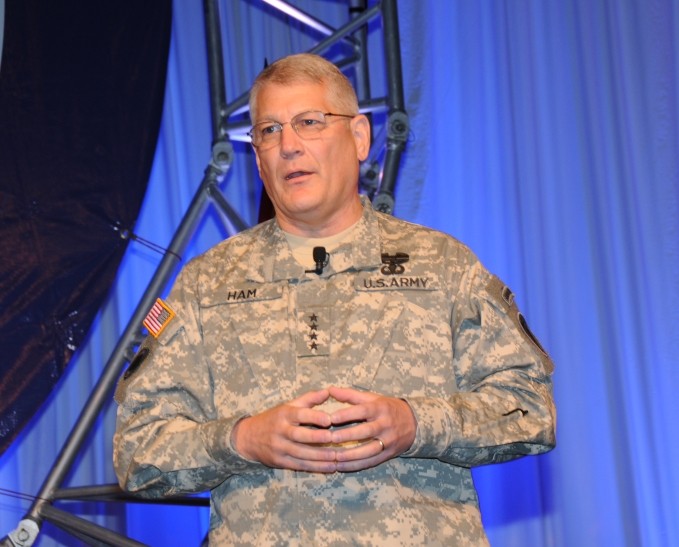FORT LAUDERDALE, Fla. -- During the opening speech of the LandWarNet 2009 conference, Gen. Carter F. Ham harked back to the fall of the Berlin Wall in 1989 and drew parallels between it and walls that exist in the governance of the Army's network.
Cultural transformations and teamwork that led to the fall of the Berlin Wall in Germany will be necessary to execute the Army's concept of being able to complete the full spectrum of operations, said Ham, Commanding General of the U.S. Army, Europe and Seventh Army, at the conference held at the Broward County Convention Center, Fort Lauderdale, Fla.
"We have to build the alliances that we will need for future operations today," he said.
Ham spoke of an immediate need to develop methods to remove some of the firewalls that exist today. Secure access should be extended across the network while allowing network users to collaborate safely, he said. The Army will need an affordable network that warrants collaboration and information sharing.
Many Soldiers and college students in Germany have no recollection of the division that existed between Russia and Germany before the wall's collapse, he said. The free information flow enjoyed in many places throughout the world today were denied or suppressed, he added.
"The wall collapsed because it artificially separated two worlds that wanted to be one," he said.
The wall, which was constructed in June of 1961, was erected by the German Democratic Republic of East Germany and completely encircled West Berlin. The physical barrier separated West Berlin from East Germany, including East Berlin. This symbolic division or Iron Curtain between Western Europe and the Eastern Bloc divided Europe both physically and ideologically from the end of World War II in 1945 until the end of the Cold War in 1991.
During the Cold War, the Soviet Union took an operational approach to controlling information. It was firewalled, so people could not connect to it and compartmentalized for control, Ham said.
The Berlin Wall fell due to the systematic collapse of walls that couldn't be sustained due to the natural human inclination to share information, he said. Walls which prevent users from accessing information that exist within the Army's network will eventually come down, as well. It is important to determine if this will be done on the military's own terms or on the terms of others, as was the case in the Soviet Union, he said.
Each day, the United States Army in Germany lives in a joint and multinational environment, he said. About 42,000 Soldiers are serving in Europe today. At any given time about one-third of Europe's Soldiers are deployed to Iraq and Afghanistan. Others are deployed to the European and African Commands or Kosovo.
More than 200,000 Soldiers were stationed in Europe when Ham first joined the Army in the mid-1970s. At the time, it was an Army that knew its enemy. It understood the enemy's doctrine, thinking process of their leaders and how they trained and fought. The enemy, however, had the same knowledge of the U.S. Army, he said.
The environment was dangerous, yet simplistic, whereas today is much more complex, he said.
Signal architecture was always an afterthought to an operation. Today, however, "it's no longer an afterthought," he said.


Social Sharing